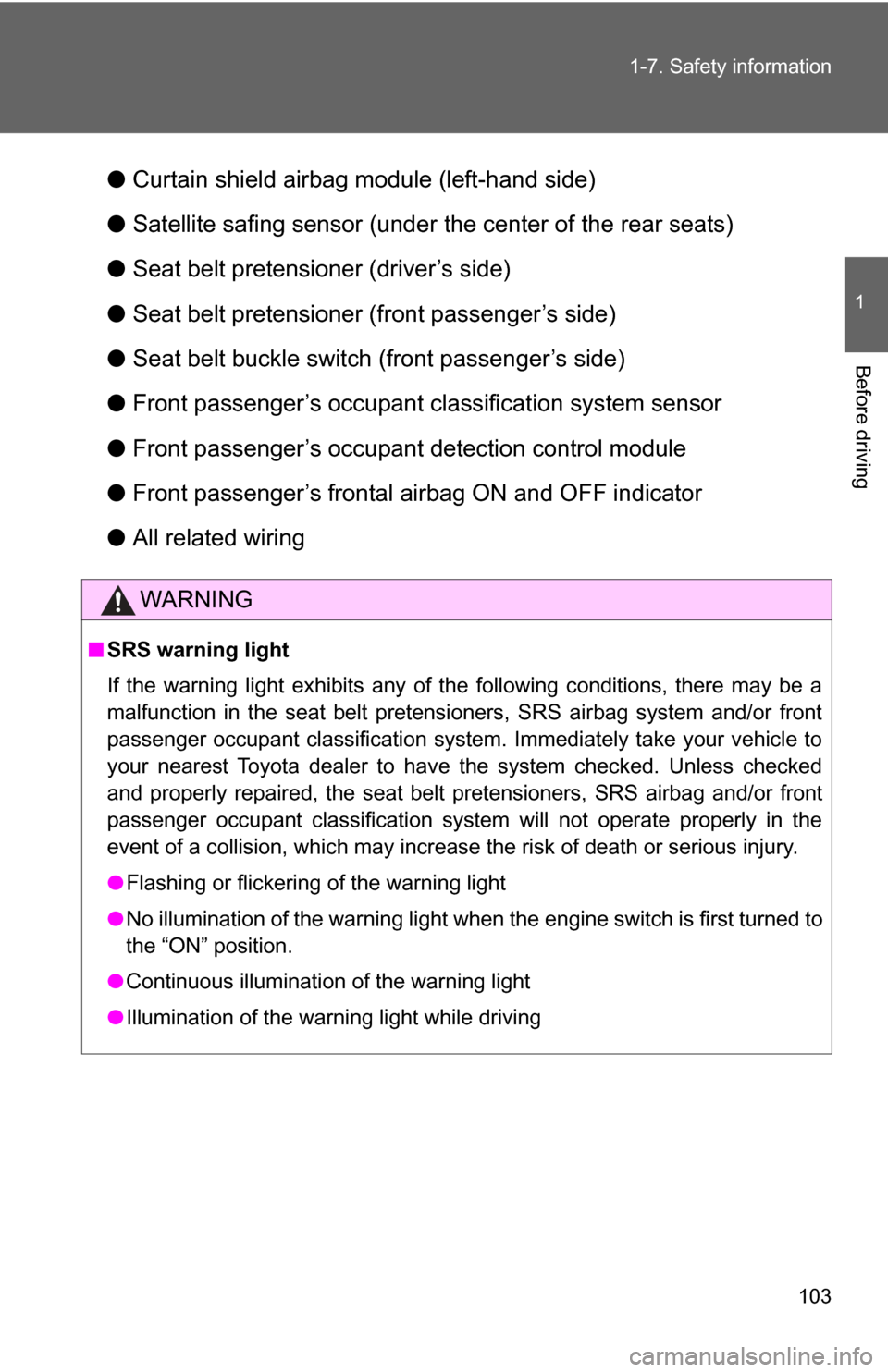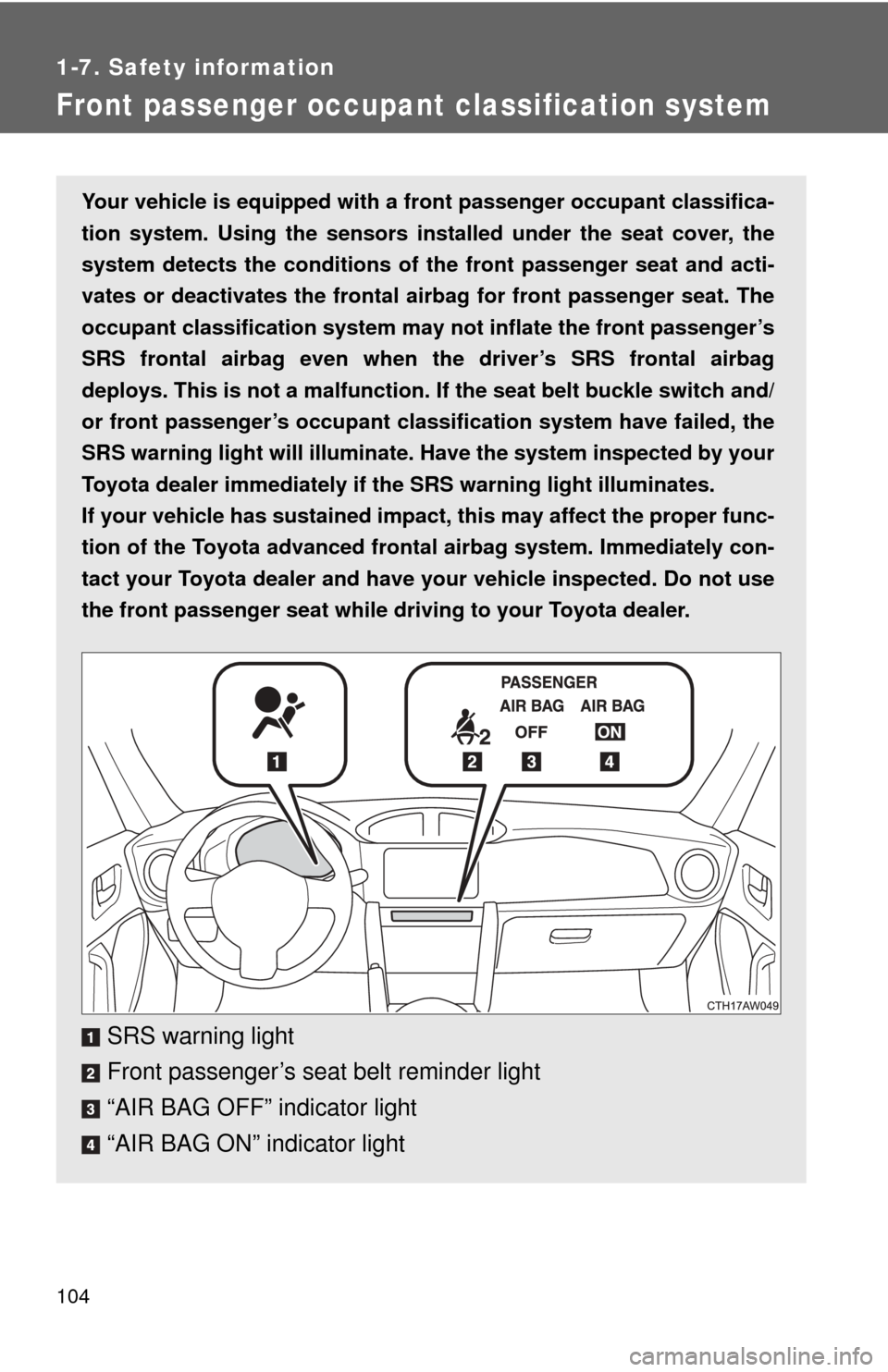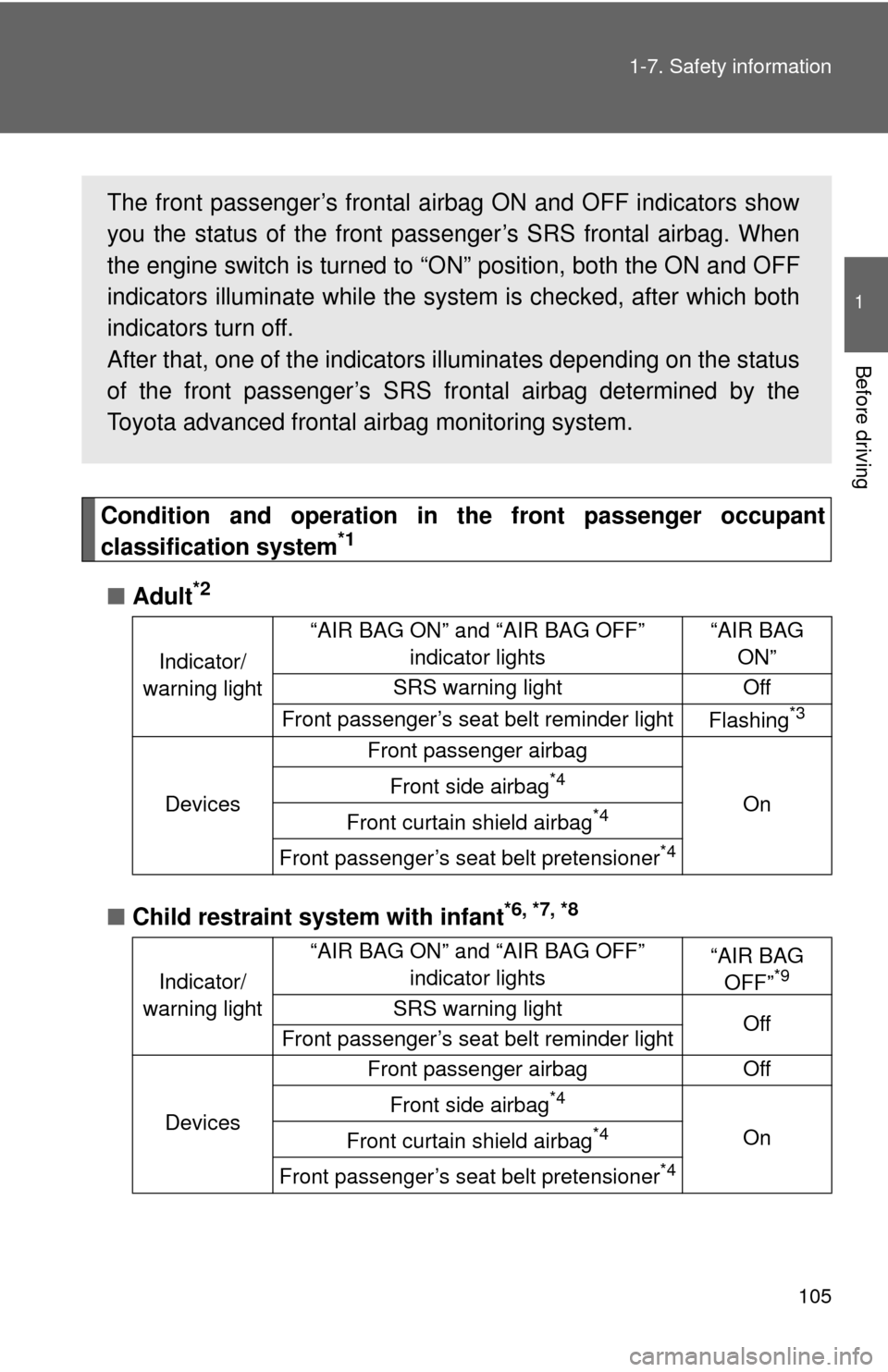warning light TOYOTA GT86 2017 1.G User Guide
[x] Cancel search | Manufacturer: TOYOTA, Model Year: 2017, Model line: GT86, Model: TOYOTA GT86 2017 1.GPages: 428, PDF Size: 7.83 MB
Page 74 of 428

74 1-7. Safety information
■Driver’s SRS frontal airbag
The driver’s SRS frontal airbag uses a dual stage inflator. The inflator oper-
ates in different ways depending on the severity of impact.
Have the system inspected by your Toyota dealer immediately if the SRS
warning light illuminates.
NOTE
The driver’s SRS side airbag and SRS curtain shield airbag are not con-
trolled by the Toyota advanced frontal airbag system.
■ Front passenger’s SRS frontal airbag
The front passenger’s SRS frontal airbag uses a dual stage inflator. The
inflator operates in different ways depending on the severity of impact.
The occupant classification system sensor is installed under the seat uphol-
stery and monitors the physique and posture of the front passenger. Using
this information, the occupant classification system determines whether \
the
front passenger’s SRS frontal airbag should be deployed or not.
The occupant classification system may not inflate the front passenger’s
SRS frontal airbag even when the driver’s SRS frontal airbag deploys. This
is normal. In this case, although the front passenger’s SRS frontal airbag
does not operate, the front passenger’s seat belt pretensioner operates with
the driver’s seat belt pretensioner. For details about the seat belt preten-
sioner, refer to “Seat belt pretensioners”. ( →P. 43)
Observe the following precautions. Failure to do so may prevent the Toyota
advanced frontal airbag system from functioning correctly or cause the sys-
tem to fail.
● Do not apply any strong impact to the front passenger’s seat.
● Do not spill liquid on the front passenger’s seat. If liquid is spilled, wipe it
off immediately.
● Do not remove or disassemble the front passenger’s seat.
● Do not install any accessory (such as an audio amplifier) other than a
genuine Toyota accessory under the front passenger’s seat.
● Do not place anything (shoes, umbrella, etc.) under the front passenger’s
seat.
● Do not place a magnet near the seat belt buckle.
Page 75 of 428

75
1-7. Safety information
1
Before driving
If the seat belt buckle switch and/or front passenger’s occupant classification
system have failed, the SRS warning light will illuminate. Have the system
inspected by your Toyota dealer immediately if the SRS warning light illumi-
nates.
If your vehicle has sustained impact, this may affect the proper function of
the Toyota advanced frontal airbag system. Have your vehicle inspected at
your Toyota dealer. Do not use the front passenger’s seat while driving the
vehicle to your Toyota dealer.
NOTE
The front passenger’s SRS side airbag an
d SRS curtain shield airbag are
not controlled by the Toyota advanced frontal airbag system.
■ Passenger’s frontal airbag ON and OFF indicators
→P. 104
■ Occupant classification system
The occupant classification system sensor is installed under the seat uphol-
stery and monitors the physique and posture of the front passenger. Using
this information, the occupant classification system determines whether the
front passenger’s SRS frontal airbag should be deployed or not.
If the front passenger’s seat cushion is wet, this may adversely affect the
ability of the system to determine deployment. If the seat cushion is wet, the
front passenger should stop sitting on the front passenger’s seat. Wipe off
liquid from the seat immediately, let the seat dry naturally and then check the
SRS warning light as follows.
●If the SRS warning light illuminates, keep the seat dry until the warning
light turns off. If the SRS warning light stays on even when the seat has
dried, do not allow anyone to sit on the front passenger’s seat and have
the system checked by your Toyota dealer.
● If the SRS warning light does not illuminate, check that the front passen-
ger’s frontal airbag ON and OFF indicators work properly. If the indicators
do not work properly, do not allow anyone to sit on the front passenger’s
seat and have the system checked by your Toyota dealer.
Page 98 of 428

98 1-7. Safety information
WARNING
■SRS airbag precautions
●The SRS driver airbag deploys with considerable force, and can cause
death or serious injury especially if the driver is very close to the airbag.
The National Highway Traffic Safety Administration (“NHTSA”) advises:
Since the risk zone for the driver’s airbag is the first 2 - 3 in. (50 - 75 mm)
of inflation, placing yourself 10 in. (250 mm) from your driver airbag pro-
vides you with a clear margin of safety. This distance is measured from the
center of the steering wheel to your breastbone. If you sit less than 10 in.
(250 mm) away now, you can change your driving position in several
ways:
• Move your seat to the rear as far as you can while still reaching the pedals comfortably.
• Slightly recline the back of the seat. Although vehicle designs vary, many drivers can achieve the 10 in. (250 mm) distance, even with the
driver seat all the way forward, simply by reclining the back of the seat
somewhat. If reclining the back of your seat makes it hard to see the
road, raise yourself by using a firm, non-slippery cushion, or raise the
seat if your vehicle has that feature.
• If your steering wheel is adjustable, tilt it downward. This points the air- bag toward your chest instead of your head and neck.
The seat should be adjusted as recommended by NHTSA above, while
still maintaining control of the foot pedals, steering wheel, and your view of
the instrument panel controls.
● The SRS front passenger airbag also deploys with considerable force, and
can cause death or serious injury especially if the front passenger is v\
ery
close to the airbag. The front passenger seat should be as far from the air-
bag as possible with the seatback adjusted, so the front passenger sits
upright.
● Improperly seated and/or restrained infants and children can be killed or
seriously injured by a deploying airbag. An infant or child who is too small
to use a seat belt should be properly secured using a child restraint sys-
tem. Toyota strongly recommends that all infants and children be placed in
the rear seats of the vehicle and properly restrained. The rear seats are
safer for infants and children than the front passenger seat. ( →P. 112)
Page 102 of 428

102 1-7. Safety information
SRS airbag system monitorsA diagnostic system continually
monitors the readiness of the
SRS airbag system (including
front seat belt pretensioners)
while the vehicle is being driven.
The SRS warning light will show
normal system operation by illu-
minating for approximately 6
seconds when the engine switch
is turned to the “ON” position.
The following components are monitored by the indicator:
● Front sub sensor (right-hand side)
● Front sub sensor (left-hand side)
● Airbag control module (including impact sensors and rollover sen-
sors)
● Frontal airbag module (driver’s side)
● Frontal airbag module (front passenger’s side)
● Side airbag sensor (center pillar right-hand side)
● Side airbag sensor (center pillar left-hand side)
● Door impact sensor (right-hand side)
● Door impact sensor (left-hand side)
● Side airbag module (driver’s side)
● Side airbag module (front passenger’s side)
● Curtain shield airbag sensor (rear wheel house right-hand side)
● Curtain shield airbag sensor (rear wheel house left-hand side)
● Curtain shield airbag module (right-hand side)
Page 103 of 428

103
1-7. Safety information
1
Before driving
●
Curtain shield airbag module (left-hand side)
● Satellite safing sensor (under the center of the rear seats)
● Seat belt pretensioner (driver’s side)
● Seat belt pretensioner (front passenger’s side)
● Seat belt buckle switch (front passenger’s side)
● Front passenger’s occupant classification system sensor
● Front passenger’s occupant detection control module
● Front passenger’s frontal airbag ON and OFF indicator
● All related wiring
WARNING
■SRS warning light
If the warning light exhibits any of the following conditions, there may be a
malfunction in the seat belt pretensioners, SRS airbag system and/or front
passenger occupant classification system. Immediately take your vehicle to
your nearest Toyota dealer to have the system checked. Unless checked
and properly repaired, the seat belt pretensioners, SRS airbag and/or front
passenger occupant classification system will not operate properly in the
event of a collision, which may increase the risk of death or serious injury.
●Flashing or flickering of the warning light
● No illumination of the warning light when the engine switch is first turned to
the “ON” position.
● Continuous illumination of the warning light
● Illumination of the warning light while driving
Page 104 of 428

104
1-7. Safety information
Front passenger occupant classification system
Your vehicle is equipped with a front passenger occupant classifica-
tion system. Using the sensors installed under the seat cover, the
system detects the conditions of the front passenger seat and acti-
vates or deactivates the frontal ai rbag for front passenger seat. The
occupant classification system may not inflate the front passenger’s
SRS frontal airbag even when the driver’s SRS frontal airbag
deploys. This is not a malfunction. If the seat belt buckle switch and/
or front passenger’s occupant classification system have failed, the
SRS warning light will illuminate. Have the system inspected by your
Toyota dealer immediately if the SRS warning light illuminates.
If your vehicle has sust ained impact, this may affect the proper func-
tion of the Toyota advanced frontal airbag system. Immediately con-
tact your Toyota dealer and have your vehicle inspected. Do not use
the front passenger seat while driv ing to your Toyota dealer.
SRS warning light
Front passenger’s seat belt reminder light
“AIR BAG OFF” indicator light
“AIR BAG ON” indicator light
Page 105 of 428

105
1-7. Safety information
1
Before driving
Condition and operation in th
e front passenger occupant
classification system*1
■ Adult*2
■Child restraint system with infant*6, *7, *8
Indicator/
warning light “AIR BAG ON” and “AIR BAG OFF”
indicator lights “AIR BAG
ON”
SRS warning light Off
Front passenger’s seat belt reminder light Flashing
*3
DevicesFront passenger airbag
On
Front side airbag
*4
Front curtain shield airbag*4
Front passenger’s seat belt pretensioner*4
Indicator/
warning light “AIR BAG ON” and “AIR BAG OFF”
indicator lights “AIR BAG
OFF”*9
SRS warning light Off
Front passenger’s seat belt reminder light
Devices Front passenger airbag
Off
Front side airbag
*4
On
Front curtain shield airbag*4
Front passenger’s seat belt pretensioner*4
The front passenger’s frontal airbag ON and OFF indicators show
you the status of the front pass enger’s SRS frontal airbag. When
the engine switch is turned to “O N” position, both the ON and OFF
indicators illuminate while the system is checked, after which both
indicators turn off.
After that, one of the indicators illuminates depending on the status
of the front passenger’s SRS fr ontal airbag determined by the
Toyota advanced frontal ai rbag monitoring system.
Page 106 of 428

106 1-7. Safety information
■Child*5, *7
■Unoccupied
■ There is a malfunction in the system
Indicator/
warning light “AIR BAG ON” and “AIR BAG OFF”
indicator lights “AIR BAG
OFF” or “AIR BAG ON”*5
SRS warning light Off
Front passenger’s seat belt reminder light Off or
flashing
*3, *5
Devices Front passenger airbag Off or on
*5
Front side airbag*4
On
Front curtain shield airbag*4
Front passenger’s seat belt pretensioner*4
Indicator/
warning light “AIR BAG ON” and “AIR BAG OFF”
indicator lights “AIR BAG
OFF”
SRS warning light Off
Front passenger’s seat belt reminder light
Devices Front passenger airbag
Off
Front side airbag
*4
On
Front curtain shield airbag*4
Front passenger’s seat belt pretensioner*4
Indicator/
warning light “AIR BAG ON” and “AIR BAG OFF”
indicator lights “AIR BAG
OFF”
SRS warning light On
Front passenger’s seat belt reminder light Off
Devices Front passenger airbag
Off
Front side airbag
*4
On
Front curtain shield airbag*4
Front passenger’s seat belt pretensioner*4
Page 110 of 428

110 1-7. Safety information
WARNING
■Front passenger occupant classification system precautions
Observe the following precautions regarding front passenger occupant clas-
sification system.
Failure to do so may cause the occupant classification system to not function
correctly, resulting in death or serious injury.
●Wear the seat belt properly.
● Do not apply excessive force to the seat.
● Do not put sharp object(s) on the seat or pierce the seat upholstery.
● Do not put objects under the front passenger seat.
● Do not use a seat accessory, such as a cushion or seat cover, that covers
the seat cushion surface.
● Do not spill liquid on the front passenger seat. If liquid is spilled, wipe it off
immediately and dry the seat. If the airbag warning light illuminates, dry
the seat until the warning light turns off. If the airbag warning light stays on
even when the seat has dried, do not allow anyone to sit on the front pas-
senger seat and have the system checked by your Toyota dealer. If the air-
bag warning light does not illuminate, check that the airbag ON/OFF
indicator light works properly. If the indicator light does not work properly,
do not allow anyone to sit in the front passenger’s seat and have the sys-
tem inspected by your Toyota dealer.
● Do not remove or disassemble the front passenger seat. Also, do not
replace or modify the seat upholstery or foam inside the seat.
● Do not install any accessory (such as an audio amplifier) other than a gen-
uine Toyota accessory under the front passenger’s seat.
● Do not place a magnetized items near the seat belt buckle.
Page 114 of 428

114 1-7. Safety information
WARNING
■Child restraint precautions
●For effective protection in automobile accidents and sudden stops, a child
must be properly restrained, using a seat belt or child restraint system
depending on the age and size of the child. Holding a child in your arms is
not a substitute for a child restraint system. In an accident, the child can be
crushed against the windshield, or between you and the vehicle's interior.
● Toyota strongly urges the use of a proper child restraint system that con-
forms to the size of the child, installed on the rear seat. According to acci-
dent statistics, the child is safer when properly restrained in the rear seat
than in the front seat.
● Never install a rear-facing child restraint system on the front passenger
seat even if the “AIR BAG OFF” indicator light is illuminated. In the event
of an accident, the force of the rapid inflation of the front passenger airbag
can cause death or serious injury to the child if the rear-facing child
restraint system is installed on the front passenger seat.
● A forward-facing child restraint system may be installed on the front pas-
senger seat only when it is unavoidable. A child restraint system that
requires a top tether strap should not be used in the front passenger seat
since there is no top tether strap anchor for the front passenger seat.
Adjust the seatback as upright as possible and always move the seat as
far back as possible even if the “AIR BAG OFF” indicator light is illumi-
nated, because the front passenger airbag could inflate with considerable
speed and force. Otherwise, the child may be killed or seriously injured.